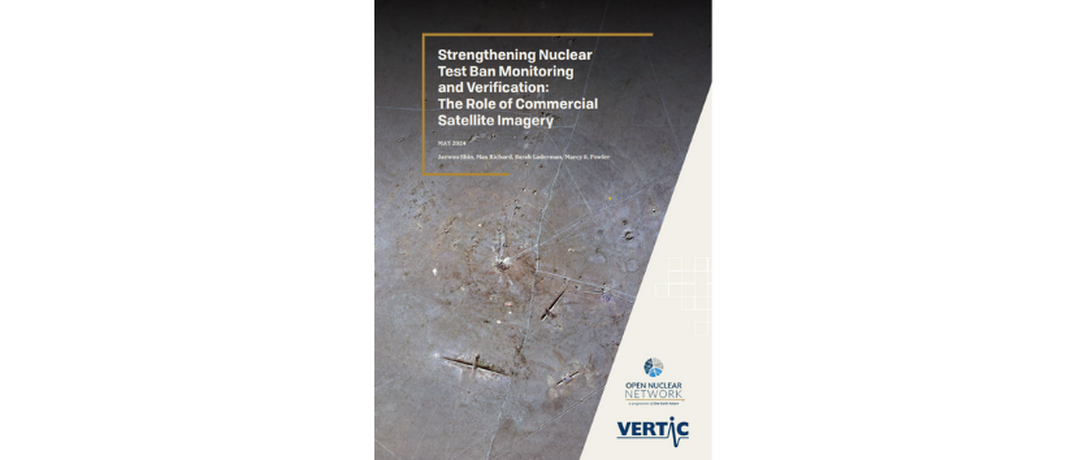
This report is an outcome of a two-part project titled "Strengthening nuclear test ban monitoring via nongovernmental satellite imagery analysis and mechanisms for resolving compliance concerns," supported by the Foreign, Commonwealth & Development Office’s Counter Proliferation Programme.
Executive Summary
This report details key findings of four case studies that examined developments at select nuclear test sites with the use of commercially available satellite imagery and other supporting open-source information. Specifically, the report summarises findings of developments from July 2023 until March 2024 observed at the Democratic People’s Republic of Korea’s (DPRK) Punggye-ri test site, the United States’ Nevada National Security Sites, the Russian Federation’s Novaya Zemlya/Central Test Site, and the People’s Republic of China’s Lop Nur test site. Together, these studies sought to examine in practical ways how commercially available satellite imagery can best be used for monitoring and verification purposes, and for increasing transparency surrounding activities at test sites where little other information is available to determine the nature of specific developments. While the four sites differ in scale, development, and their geographies, analysis of tasked and ordered satellite imagery and available open-source information suggests that all four sites are undergoing continued maintenance and intermittent modernisation activities. There have been no indications of imminent test preparations or an imminent return to a full-scale nuclear testing regime. For all sites, however, subcritical or small-scale supercritical experiments cannot be excluded, as any possible indications are less or not observable through remote sensing. The observed activities indicate that all four states aim to retain some infrastructure to resume nuclear testing, should they decide to do so.
Punggye-ri
Democratic People’s Republic of Korea
During the analysis period, observations indicated only site maintenance activities. Some minor vehicle and personnel presence and minor activity at the administrative areas and at one restored tunnel was observed. While no activities that would suggest active preparations for imminent testing were observed, it is possible that no major additional activities would be required to quickly field a test. The site is now likely in a standby mode, pending a decision by the political leadership to further restore it for improved test readiness or to actively prepare for a nuclear test.
Novaya Zemlya/Central Test Site
Russian Federation
The Novaya Zemlya test site was also observed undergoing maintenance and modernisation. Observed activities appeared to be consistent with official statements that Russia intends to maintain test readiness. At least six horizontal tunnels appear, externally, to be in an operable condition, but no indications were identified that suggested preparations for an imminent nuclear test or a return to a full-scale nuclear testing regime.
Nevada National Security Sites
USA
The Nevada National Security Sites (NNSS) were similarly observed undergoing maintenance and modernisation. From satellite imagery alone, it is nearly impossible to see clear indications of the difference between conventional explosives and subcritical or potential small-scale supercritical nuclear experiments when conducted in horizontal tunnels or in fully underground facilities. However, what was observed over the period analysed for this report was consistent with known U.S. policy and other sources of open-source information about activities on the site. No indications were identified suggesting preparations for an imminent nuclear test or a return to a full-scale nuclear testing regime.
Lop Nur (No. 21 Base)
People’s Republic of China
Lop Nur was observed undergoing maintenance and possible expansion. Available satellite imagery showed that Lop Nur has undergone modernisation and expansion throughout the past decade and continuing in 2023–2024. Activities observed at Lop Nur suggested that China wants to continue to maintain some test readiness capability. These activities included the construction of a new horizontal tunnel, vertical drilling activities, and potential initial excavations for another underground facility. However, the exact purpose of these activities remains unclear. No indications were identified that suggested preparations for an imminent nuclear test or a return to a full-scale nuclear testing regime.
Findings demonstrate that using commercially available satellite imagery for monitoring test site activities can increase understanding of broad trends and patterns of activities, and support official statements or raise questions about their veracity. Imagery analysis is a potent verification and monitoring tool that should ideally be leveraged as part of a more extensive toolkit, such as the CTBTO’s verification regime. At the same time, there are significant limitations to relying only on remote sensing sources and methods to attempt to determine the nature of observed activities and verify compliance. Much of the observed activity remains ambiguous, with multiple alternative explanations conceivable that cannot be excluded from information drawn from available satellite images and other open-source information alone.
As such, these findings further highlight the crucial role of transparency. When states offer public information on the maintenance and usage of test sites, they can demonstrate compliance with testing moratoria. Greater levels of transparency can enable others, including other states, international organization, and civil society to independently verify compliance more accurately, significantly minimizing the risk of misunderstandings.
Access the full report as a PDF here or on the right-hand side.